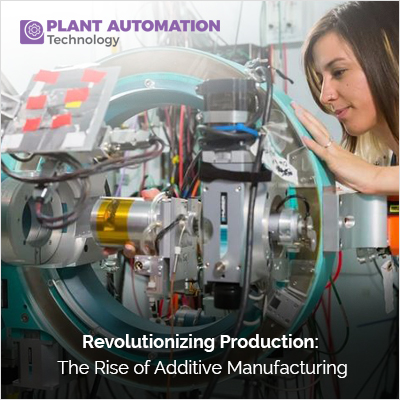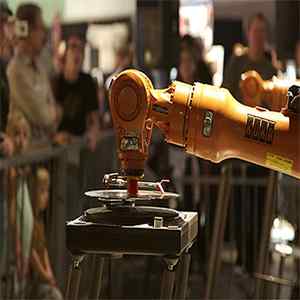Revolutionizing Production: The Rise of Additive Manufacturing

Introduction:
In the ever-evolving world of manufacturing, a groundbreaking technology is taking center stage: additive manufacturing. This revolutionary process, also known as 3D printing, is reshaping the way products are made, from intricate prototypes to fully functional end-use parts.
Prepare to witness the manufacturing landscape undergo a profound transformation. Welcome to the rise of additive manufacturing, a groundbreaking technology that is revolutionizing production processes. With this game-changing innovation, commonly referred to as 3D printing, the way products are designed and manufactured is forever altered.
Blending precision and creativity, additive manufacturing has quickly become a game-changer in the manufacturing industry. By adding material layer by layer, complex and customized objects are created with astonishing speed and remarkable efficiency. From prototypes to end-use parts, this cutting-edge technology is catapulting manufacturing into a new era of limitless possibilities.
Join us on a journey as we delve deeper into the world of additive manufacturing, exploring its immense potential, the industries it is disrupting, and the future it promises. Get ready to witness the transformation as this groundbreaking technology redefines production as we know it.
Understanding the History of Traditional Manufacturing
Traditional manufacturing methods have played a significant role in shaping the modern world. From the Industrial Revolution to mass production, these techniques have allowed for the creation of goods on a large scale. However, they are not without their limitations. Traditional manufacturing often requires complex and costly tooling, resulting in longer lead times and higher costs. Additionally, the process is not easily adaptable to customization, limiting the ability to create unique and personalized products.
What is Additive Manufacturing?
Additive manufacturing, also known as 3D printing, is a process that builds objects layer by layer using digital designs. Unlike traditional subtractive manufacturing, where material is removed from a solid block, additive manufacturing adds material to create the desired shape. This additive approach allows for the creation of complex geometries and intricate designs that were previously impossible or impractical to produce.
Additive manufacturing encompasses various technologies, including selective laser sintering (SLS), fused deposition modeling (FDM), and stereolithography (SLA). These technologies utilize different materials, such as plastics, metals, and ceramics, to produce objects with varying properties and characteristics. This versatility makes additive manufacturing suitable for a wide range of applications across multiple industries.
Advantages of Additive Manufacturing over Traditional Manufacturing Methods
Additive manufacturing offers several advantages over traditional manufacturing methods that make it an attractive option for businesses. One of the key benefits is the ability to create highly complex and customized designs with ease. Traditional manufacturing often requires multiple parts to be assembled, resulting in additional costs and potential weak points. With additive manufacturing, intricate designs can be produced as a single piece, eliminating the need for assembly and reducing the risk of failure.
Another advantage of additive manufacturing is the reduction in material waste. Traditional manufacturing often generates a significant amount of scrap material, which is costly and environmentally unfriendly. Additive manufacturing only uses the exact amount of material required to build the object, minimizing waste and making it a more sustainable option.
Additive manufacturing also allows for faster prototyping and production cycles. With traditional manufacturing, creating prototypes can be time-consuming and expensive. Additive manufacturing enables rapid prototyping, allowing for quick iterations and design improvements. Additionally, the ability to produce objects on-demand reduces lead times, enabling businesses to respond quickly to market demands and customer needs.
Applications of Additive Manufacturing in Various Industries
Additive manufacturing is revolutionizing numerous industries, from aerospace and automotive to healthcare and consumer goods. In aerospace, the ability to create lightweight and complex components is crucial for improving fuel efficiency and performance. Additive manufacturing allows for the production of intricate structures that are not achievable with traditional methods. This technology is also being used to create custom implants and prosthetics in the healthcare industry, providing patients with personalized solutions that improve quality of life.
In the automotive industry, additive manufacturing is being utilized for rapid prototyping, tooling, and even production of end-use parts. This technology enables manufacturers to reduce costs, streamline processes, and create innovative designs. In the consumer goods sector, additive manufacturing is transforming the way products are designed and manufactured. Customizable jewelry, personalized home decor, and unique fashion pieces are just a few examples of the endless possibilities offered by additive manufacturing.
Challenges and Limitations of Additive Manufacturing
While additive manufacturing has immense potential, it also faces certain challenges and limitations. One of the key challenges is the limited range of materials available for printing. While there has been significant progress in expanding the material options, certain materials, such as high-performance metals, are still challenging to print with the required quality and consistency.
Additionally, the mechanical properties of printed parts can differ from those produced using traditional manufacturing methods, requiring thorough testing and validation.
Another limitation is the size constraint of additive manufacturing. The build volume of most 3D printers is limited, making it difficult to produce large-scale objects. This can be a hindrance in industries where size is a critical factor, such as construction or shipbuilding. However, advancements in technology are continually pushing the boundaries of size limitations, opening up new possibilities for additive manufacturing.
Additive Manufacturing Materials and Technologies
Additive manufacturing utilizes a wide range of materials, each with its unique characteristics and applications. Plastics, such as ABS and PLA, are commonly used for prototyping and low-cost production. They offer good strength and durability, making them suitable for a variety of applications. Metals, including titanium, aluminum, and stainless steel, are used for producing high-performance parts with excellent mechanical properties. Ceramics, such as zirconia and alumina, are utilized in industries where heat resistance and electrical insulation are crucial.
There are also various technologies employed in additive manufacturing, each with its advantages and limitations. Selective laser sintering (SLS) uses a laser to fuse powdered materials together, creating solid objects layer by layer. Fused deposition modeling (FDM) extrudes melted material through a nozzle to build the object. Stereolithography (SLA) utilizes a laser to cure liquid resin, creating solid parts. Each technology has its applications and is chosen based on factors such as material compatibility, resolution, and cost.
How to Implement Additive Manufacturing in Your Business?
Implementing additive manufacturing in your business can be a transformative process. To get started, it is essential to assess your specific needs and identify areas where additive manufacturing can provide value. Consider factors such as the complexity of your designs, the need for customization, and the potential cost and time savings. Conduct a feasibility study to evaluate the viability of additive manufacturing for your products and processes.
Once you have identified the areas where additive manufacturing can be implemented, it is crucial to invest in the right equipment and software. Consider factors such as build volume, material compatibility, and resolution when selecting a 3D printer. Additionally, choose software that enables efficient design and optimization of additive manufacturing processes.
Training and upskilling your workforce is also essential for successful implementation. Additive manufacturing requires a different skill set compared to traditional manufacturing methods. Invest in training programs to ensure your employees have the knowledge and expertise to operate and maintain the equipment effectively. Collaborating with experts and leveraging their experience can also accelerate the learning curve and help overcome implementation challenges.
Additive Manufacturing in the Future
The future of additive manufacturing looks promising. As technology continues to advance, we can expect to see further improvements in material options, printing speed, and resolution. This will open up new possibilities for industries that are currently limited by the constraints of additive manufacturing.
The integration of additive manufacturing with other cutting-edge technologies, such as artificial intelligence and robotics, will revolutionize production processes even further. Imagine a fully automated manufacturing facility, where robots work seamlessly with 3D printers to produce highly complex and customized objects with incredible speed and precision.
Additionally, additive manufacturing has the potential to enable sustainable production practices. By reducing material waste, streamlining supply chains, and enabling localized production, this technology can contribute to a more environmentally friendly and efficient manufacturing industry.
Conclusion: The Future of Production and the Role of Additive Manufacturing
The rise of additive manufacturing is ushering in a new era of production. With its ability to create complex designs, reduce lead times, and offer customization, this technology is revolutionizing the manufacturing industry. From aerospace and automotive to healthcare and consumer goods, additive manufacturing is disrupting various sectors, enabling innovation and pushing the boundaries of what is possible.
While additive manufacturing still faces certain challenges and limitations, ongoing advancements in materials and technology are rapidly overcoming these barriers. As businesses embrace additive manufacturing and integrate it into their operations, they can benefit from reduced costs, faster production cycles, and the ability to create unique and personalized products.
The future of production is being shaped by additive manufacturing. As this groundbreaking technology continues to evolve, we can expect to witness even greater advancements and transformations in the manufacturing landscape. The possibilities are limitless, and the journey has just begun. Embrace the rise of additive manufacturing and unlock the potential of a new era of production.







